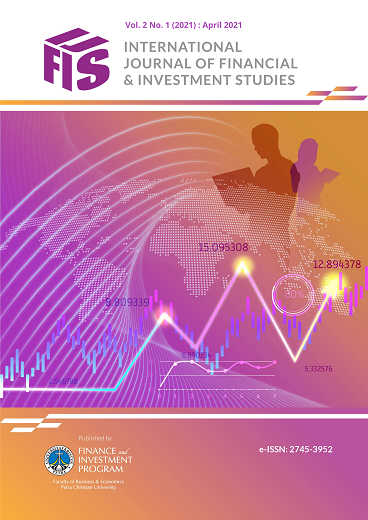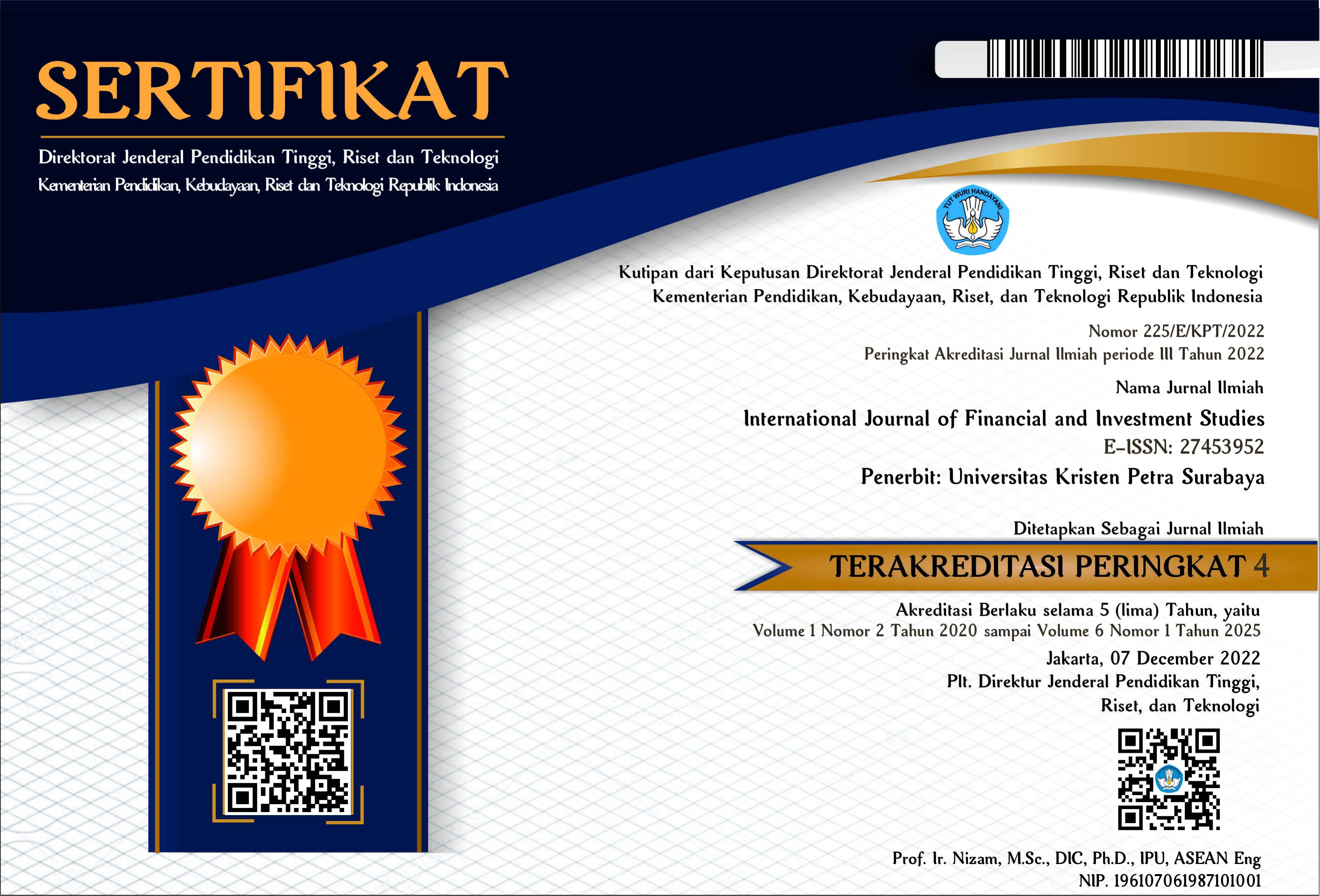ANALYSIS OF THE PERFORMANCE OF INDONESIAN MUTUAL STOCK FUNDS USING SHARPE, TREYNOR, JENSEN AND M2 METHOD PERIOD 2010 – 2019
Abstract
This study examines the performance of equity mutual funds using Sharpe, Treynor, Jensen, and M2. The sample used in this study is 57 stock mutual funds in 2015 – 2019 and 29 stock mutual funds in 2010 – 2019. The performance of stock mutual funds will be compared with LQ – 45 and IHSG to find out whether they underperform or outperform on market performance. The results showed that when seen in years 2015 - 2019 with the benchmark LQ - 45, 11 equity funds outperformed by using Sharpe, Treynor, and M2, and 12 mutual funds stocks outperformed by using a Jensen. Using the Composite Index as the benchmark, it is found that four equity funds outperformed by using Sharpe, M2, and 5 equity funds outperformed by using Treynor and Jensen from 57 samples of mutual fund shares. From the performance of the year 2010 - 2019, it is found that the 10 equity funds outperformed by using Sharpe and M2, and 15 equity funds outperformed by using Treynor and Jensen with LQ – 45 as the benchmark. The Composite Index found that 0 of stock mutual funds outperformed by using Sharpe and M2, while 3 mutual funds outperformed using Treynor and 2 mutual funds outperformed using Jensen from 29 stock mutual funds samples.
Downloads
References
Amalia, D., & Zaenal, A. (1999). Perbandingan Kinerja Reksa Dana; Periode Sebelum Krisis dan Periode Krisis. Sinergi UII.
Andi, W. (2008). Penilaian Kinerja Reksadana Saham Melalui Pendekatan Sharpe Ratio Periode Desember 2006 - Desember 2007. Jurnal Ekonomi.
Anindita, P. N. (2012). Analisis Kebijakan Alokasi Aset, Kinerja Manajer Investasi dan Tingkat Risiko Terhadap Kinerja Reksadana Saham di Indonesia. Universitas Diponegoro, Undergraduate Thesis.
Arikunto, S. (2006). Prosedur Penelitian Suatu Pendekatan Praktik. Jakarta: Rineka Cipta.
Badan Pusat Statistik. (n.d.). Retrieved from https://www.bps.go.id/
Bodie, Z., Kane, A., & Marcus, A. (2009). Investments. Singapore: The McGrawl-Hill Companies.
Clara, B. (2019). Analisis Perbandingan Kinerja Reksadana Saham Menggunakan Metode Sharpe dan Treynor Pada Reksadana Saham. Universitas Pembangunan Nasional.
Damodaran, A. (2015). Applied Corporate Finance Fourth Edition. John Wiley & Sons, Inc.
Darmadji, T., & Fakhruddin. (2012). Pasar Modal Di Indonesia, Edisi Ketiga. Jakarta: Selemba Empat.
Ed, E., & Ajay, S. (2003). Investing with a Conscience: An Evaluation of the Risk-Adjusted Performance of Socially Responsible Mutual Funds. American Journal of Business.
Fahmi, I. (2012). Analisis Kinerja Keuangan. Bandung: Alfabeta.
Franco, M., & Leah, M. (1997). Risk Adjusted Performance. Journal of Portofolio Management.
Francisca & Malelak, M.I. (2020). Pengaruh Corporate Governance Terhadap Firm’s Debt pada Perusahaan Sektor Industri Barang Konsumsi Periode 2013-2018. International Journal of Financial and Investment Studies (IJFIS), 1(1), 30-41. https://doi.org/10.9744/ijfis.1.1.30-41
Jensen, M. C. (1967). The Performance of Mutual Funds in The Period 1945–1964. Journal of Finance.
Jogiyanto. (2010). Teori Portofolio dan Analisis Investasi. Yogyakarta: BPFE.
Kidd, D. (2011). The Sharpe Ratio and The Information Ratio. Investment Performance Measurment Feature Articles.
Low, S. W., & Chin, Y. B. (2013). Refinements to The Sharpe Ratio - Evidence from Malaysian Equity Funds. Global Economic Review.
Manurung, A. H. (2000). Mengukur Kinerja Portofolio. Usahawan.
Mobius, M. (2007). Mutual Funds an Introduction to The Core Concepts. Singapore: John Wiley & Sons.
Nazir, M. (2013). Metode Penelitian. Bogor: Ghalia Indonesia.
Onur, A., Ed, E., & Ajay, S. (2007). Risk - Adjusted Performance of International Mutual Funds. Managerial Finance.
Pratama, E. P., & Nugraha, U. (2005). Reksadana Solusi Perencanaan Investasi Di Era Modern. Jakarta: PT. Gramedia Pustaka Utama.
Reilly, F. K., & Brown, K. C. (2006). Investment Analysis and Portofolio Management. USA: Thomson Higher Education.
Samsul, M. (2006). Pasar Modal dan Manajemen Portofolio. Jakarta: Erlangga.
Scholz, H., & Wilkens, M. (2005). A Jigsaw Puzzle of Basic Risk - Adjusted Performance Measures. Journal of Performance Measurement.
Sharpe, W. F. (1995). Risk, Market Sensitivity and Diversification. Financial Analysts Journal.
Siahaan, V. (2006). Menggunakan Metode Jensen dalam Pengukuran Kinerja Reksadana; Studi Kasus Tujuh Reksadana Saham. Universitas Pancasila, Undergraduate Thesis.
Stewart, S. D., Piros, C. D., & Heisler, J. C. (2019). Portofolio Management Theory and Practice. Hoboken, New York: John Wiley & Sons, Inc.,
Subandi, J.R., & Basana, S.R. (2021). The Effect of Salience and Disposition Effect on Stock Investment Decisions on Investors in Surabaya. International Journal of Financial and Investment Studies (IJFIS), 1(2), 77-84. Retrieved from https://ojs.petra.ac.id/ijfis/index.php/ijfis/article/view/56
Subramanyam, K. R. (2014). Financial Statement Analysis Eleventh Edition. Penn Plaza, New York: McGraw-Hill Education.
Sugiyono. (2013). Metode Penelitian Pendidikan Pendekatan Kuantitatif, dan R&D. Bandung: Alfabeta.
Suryawan, Y. (2003). Evaluasi Kinerja Portofolio Saham di Bursa Efek Jakarta Studi Empiris Saham - Saham LQ-45. Unpublished thesis, Universitas Diponegoro, Semarang.
Susanto, B. (2008). Pasar Modal Syariah Tinjauan Hukum. Yogyakarta: UII Press.
Tandelilin, E. (2010). Portofolio dan Investasi Teori dan Aplikasi. Yogyakarta: Kanisius.
Viena, E. (2013). Uji Konsistensi Kinerja Reksadana Saham yang Terdaftar di Bursa Efek Indonesia Periode 2008-2012. Universitas Kristen Petra, Undergraduate Thesis.
Authors who publish in this journal agree to the following terms:
- Authors retain unrestricted copyright and full publishing rights. The authors grant the Publisher the right of first publication, with the work simultaneously licensed under the terms and conditions of the Creative Commons Attribution 4.0 International License.
- Authors can enter into separate, additional contractual arrangements for the non-exclusive distribution of the journal's published version of the work (e.g., post it to an institutional repository or publish it in a book), with an acknowledgment of its initial publication in this journal.
- Authors are permitted and encouraged to post their work online (e.g., in institutional repositories or on their website) before and during the submission process, as it can lead to productive exchanges and earlier and more extraordinary citations of published work.















